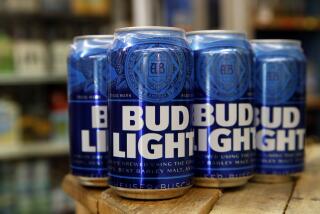Milk Mustache Ads Are a Hit, but Is Milk?
- Share via
WASHINGTON — So where’s your mustache?
Annie Liebovitz’s popular photos of celebrities with milk sloshed on their upper lips are a hit with teenage collectors. But the 4-year-old ad campaign costs consumers nearly 2 cents a gallon--and it’s unclear whether people are drinking more milk.
Government auditors say the federal board responsible for the $110-million-a-year campaign has produced no evidence that it has increased consumption.
The Agriculture Department’s inspector general has recommended suspending it until the board and USDA improve their management of it.
In addition to raising questions about the campaign’s effectiveness, the inspector cited “serious concerns” with the board’s management structure and contracting procedures. The board failed to file required reports or get USDA’s approval for $127 million in contracts, many of which were given out without competition.
Agriculture Department officials are reviewing their management of all 12 commodity promotion programs that they oversee. An earlier audit of the Cotton Board cited an array of wasteful expenditures, including a 45-minute fashion show for cotton industry executives that cost $360,000 to produce.
USDA declined to shut down the milk-mustache program, and the board says it has already addressed many problems cited. If nothing else, the ads have changed milk’s “fuddy-duddy” image, said board spokeswoman Susan Ruland.
“Milk is up against terrific competition in the beverage aisle. You can’t just look at this thing in a vacuum,” she said.
The board is financed through assessments on milk processors. Another well-known promotion program, which uses the “Got Milk?” slogan, is paid for by dairy farmers. The two campaigns will be combined in coming weeks.
Other programs promote farm products from soybeans to watermelons, potatoes and popcorn.
None is as widely recognized as the milk mustaches, a combination of milk and ice cream slathered on the celebrities’ upper lips. Spike Lee has worn one, as have Christie Brinkley, Dennis Rodman, Kristi Yamaguchi and the Hanson Brothers band, as well as Health and Human Services Secretary Donna Shalala. The board gets 300 requests a week for reprints.
The 4-year-old campaign is well regarded in the advertising industry. “It’s very creative, different, fresh,” said Judann Pollock, who follows the food industry for Advertising Age magazine.
But catchy ads don’t necessarily sell products.
“As someone said to me, if you don’t like milk, you don’t like milk. Nothing’s going to change that,” she said.
Both the board and the USDA’s Agricultural Marketing Service are required to evaluate the effectiveness of the ad campaign to see if it increases milk consumption. But the board has done no studies. Auditors say the administrator told them that he didn’t believe anyone was interested in knowing whether it had. And some numbers provided by USDA to justify the program don’t add up.
A report that the USDA submitted to Congress asserts that advertising boosted milk sales by 5.9% from October 1995 to September 1996. But the inspector general’s report says that the actual increase was 0.85% and that milk sales then fell by 0.42% over the following year.
USDA officials say the auditors misinterpreted their report, but they acknowledged that there could be other reasons for the increase, such as public concern about calcium intake.
Milk consumption has been steadily dropping for three decades, from 35.5 gallons a person in 1966 to 26.2 gallons in 1997.
While the board’s research indicates that the ads have changed public attitudes toward milk, it’s difficult to measure whether consumers are buying more as a result, said Scott Mayfield, a Tennessee milk processor who is the board’s chairman.
“Just because someone knows the facts doesn’t necessarily change their behavior,” he said.
The director of the Agricultural Marketing Service, Enrique Figueroa, said he is working with the board to develop a new organizational structure and may seek outside economists to analyze whether the ads are effective.
“Whatever we can do to increase the confidence level, we’ll pursue that,” he said.
More to Read
Inside the business of entertainment
The Wide Shot brings you news, analysis and insights on everything from streaming wars to production — and what it all means for the future.
You may occasionally receive promotional content from the Los Angeles Times.









